Kayaking the Econfina and Perdido Rivers, FL (October 2006)
![]()
The paddling guidebook states that because of the enormous number of tree pull-overs, portages, and treacherous conditions at lower water levels, the Econfina River MUST NOT be paddled when the water gauge level at the put-in point is below 2 feet. We peer over the bridge to read the gauge.
It reads 1.8 feet.
Sane, prudent, cautious men would stop dead in their tracks and call off the kayak trip at this point.
Not us.
The day is too perfect, and the rave reviews we've heard for years about this Florida Panhandle river are too tempting. We might never have another chance...
Besides, we tell ourselves, we've surely faced much worse in our many past paddling ordeals.
No, we've come too far (a five-hour drive from home) to turn back.
We recklessly launch our Necky Dolphin sit-on-top kayaks.
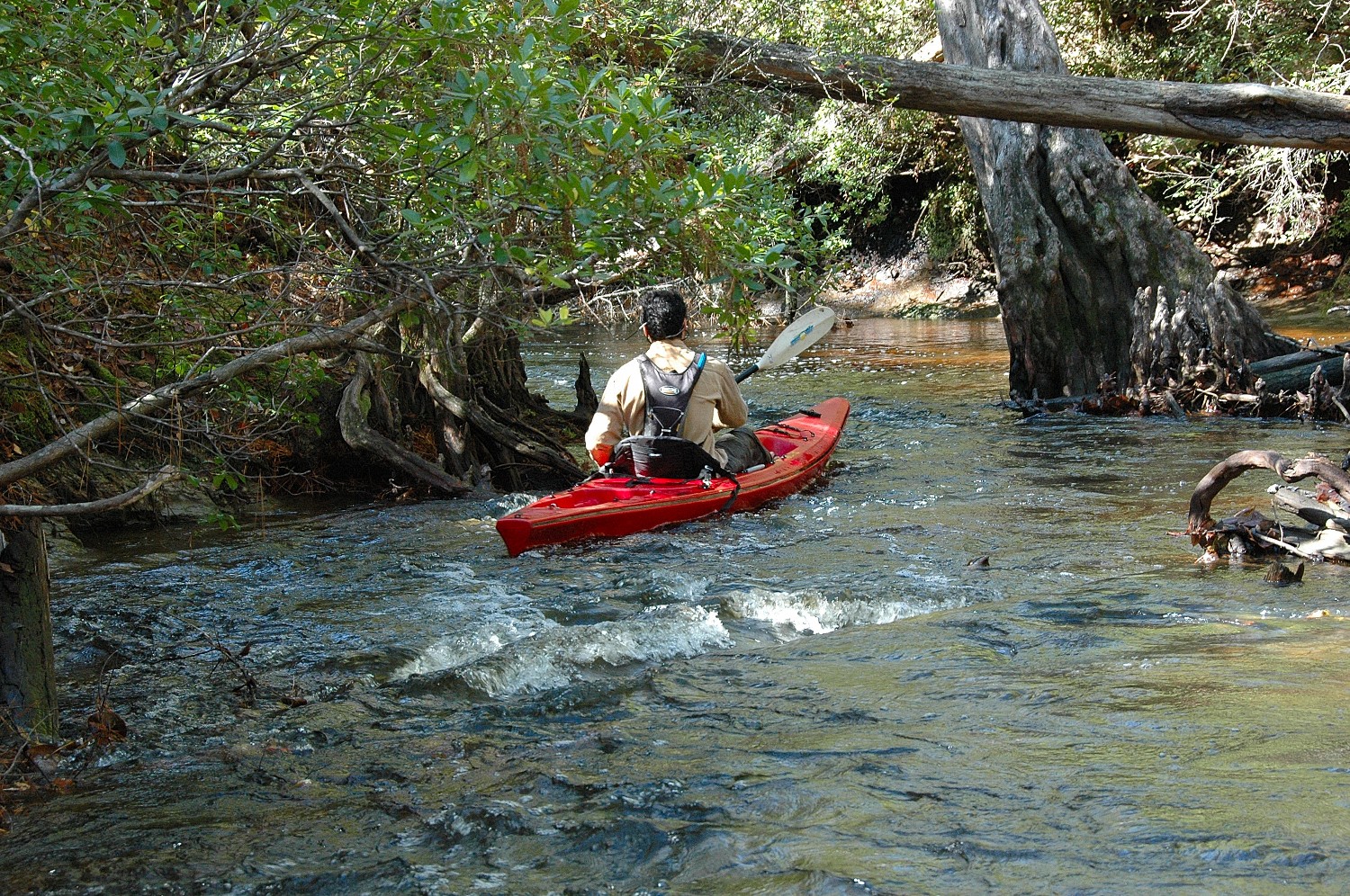
The day is absolutely perfect -- weather-wise. The temperature is a crisp 70 degrees. The air is sunny and dry. The rain from the night before has added water to a river parched by a long drought.
Before us as we paddle, the water is dappled with the glistening sunlight on the water riffles.
Yes, RIFFLES.
The Econ turns out to be a highly unusual experience for Florida. It is full of relatively high velocity water which races and boils along its narrow channel (mostly about 15 feet in width) as it runs sharp turns around abrupt, curving limestone walls and tree falls.
For much of its length, the Econ is what for Florida is an astonishing whitewater river experience.
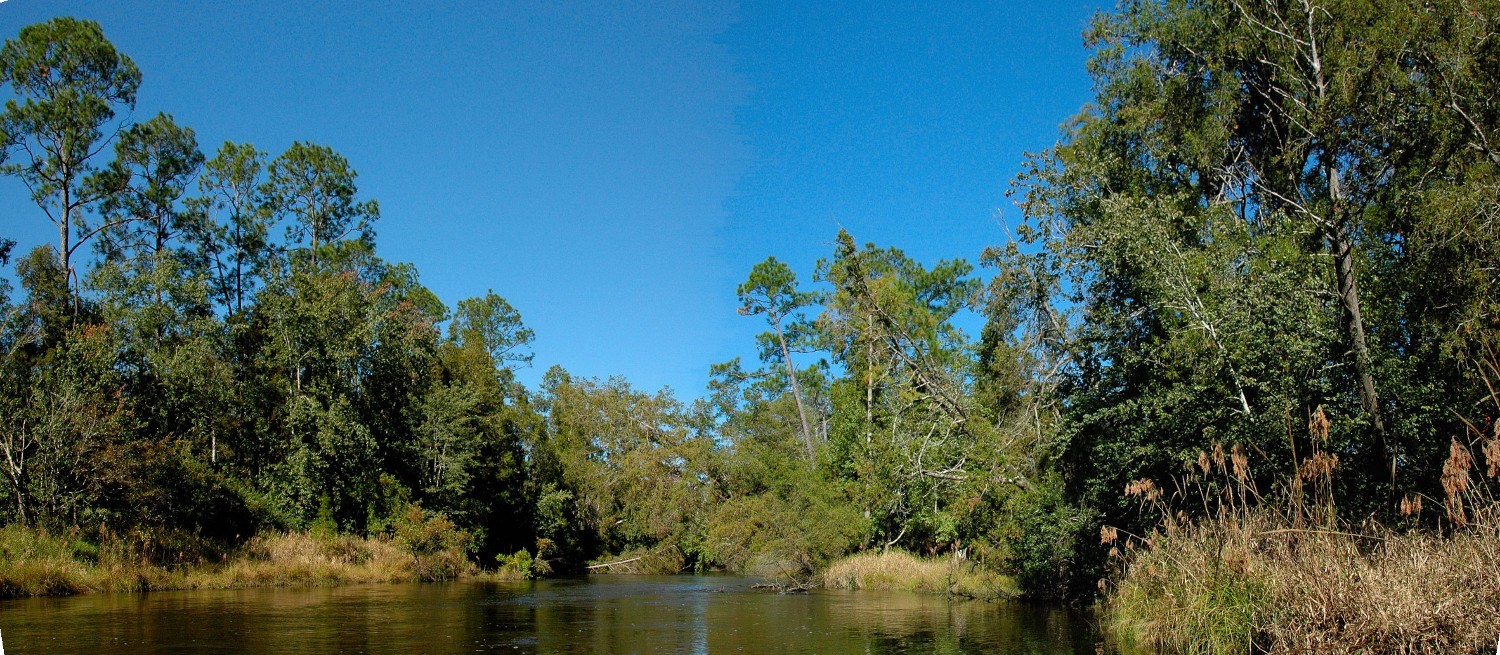
Early on, we find ourselves spilling over small waterfalls. Before we are able to catch our breath, we quickly approach sharp turns that propels us down an absolutely exhilarating, shocking DOWNSLOPE. So steep does this downslope appear that I feel myself leaning back in my kayak, disconcertingly wondering whether I have the ability to negotiate the high speeds that lie ahead. In combination with the water velocity, and the half-pipe-like, narrow limestone tunnels we plummet down for several hundred feet, the ride is rather alarming for a flat-water kayaker such as myself. "Am I still in Florida???"
I feel as if I am hurtling down a bobsled chute in the Winter Olympics. Each time we approach the beginning of one of these runs, I giddily turn back to my kayaking buddy and exclaim, "HERE WE GO AGAIN!!!!!!!!!!"
For miles, we ride this immensely enjoyable kayaking rollercoaster. It is the most fun I've ever had paddling a river.
On the flat, quiet, sun-dappled sections, the water is a lovely honey-brown color. The sheer limestone walls flanking us (they are nearly hugging us due to the narrowness of the deeply carved channel) are alive as they drip with cool, clear spring water. Several times, we pass by a thunderously roaring waterfall 10 to 15 feet tall (another out-of-character feature for Florida).
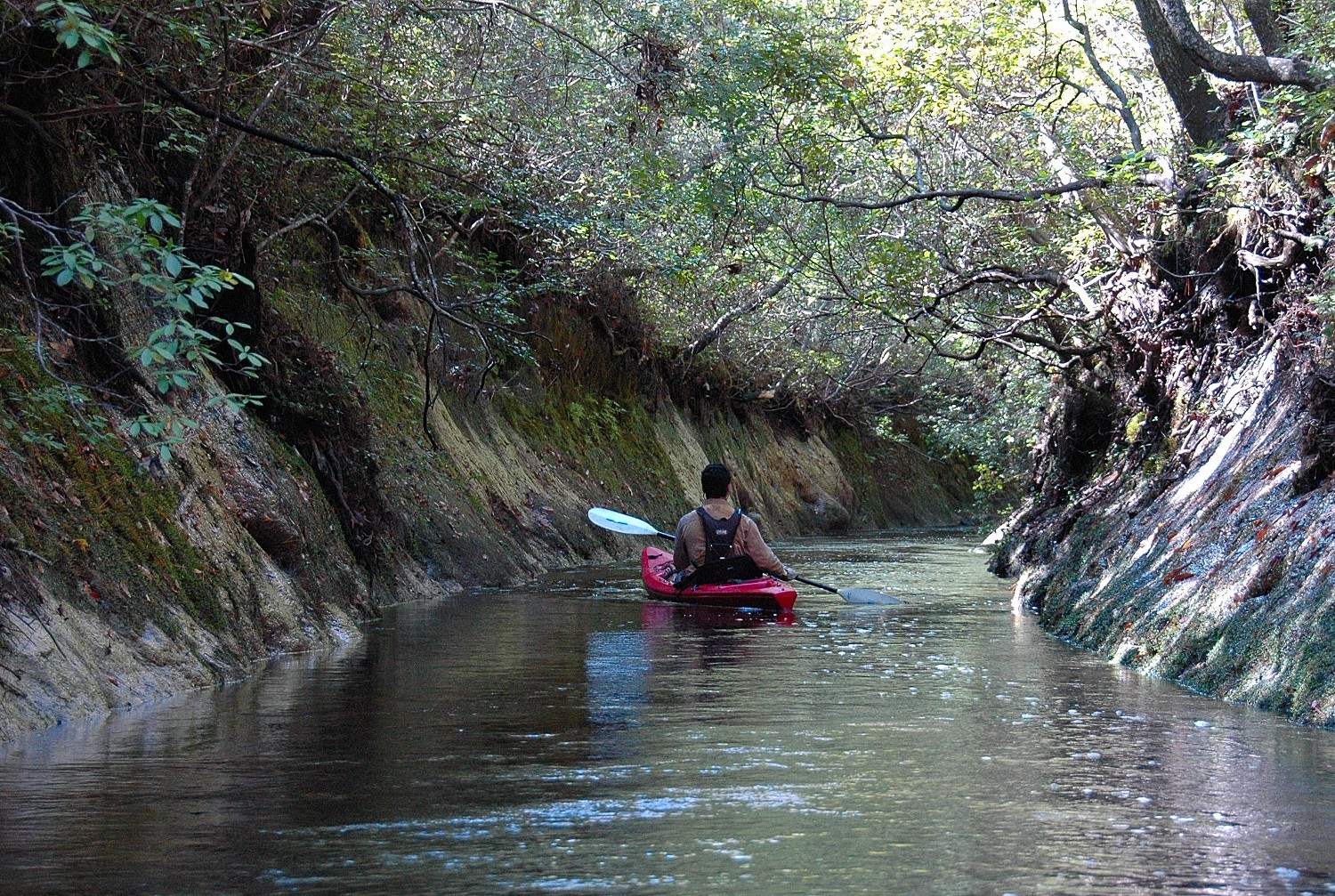
The dense forest trees easily canopy over us due to the narrow-ness of the channel, further adding to the feeling of being enveloped within a forested tunnel.
The high-velocity current, and the sharp turns in the limestone and fallen trees makes this, under normal water conditions, a highly technical paddle that only the most skilled paddlers should consider sampling. This river is not for a novice.
There is no margin for error.
All of our kayaking abilities are tested -- particularly paddling cross-current and keeping a straight line. Pulling alongside a fallen tree (to pull the boat over it) is particularly dangerous, as the strong current will quickly overturn the unsuspecting kayaker. Indeed, on this day my boat flips twice (which ordinarily never happens to me). On the first flipping, my highly coveted Nikon camera and wide-angle lens are unceremoniously dumped into the water, surely ruining both the lens and the camera body.
We had been told by a paddler at the put-in point that we could expect approximately 20 tree pull-overs along the 10-mile stretch from our start just north of the Town of Fountain. Instead, I count 8.5 of them. All in all, and comparatively speaking, such a small number of pull-overs is virtually clear sailing.
At one point approximately five miles into our adventure, we come upon an "S"-shaped limestone wall formation that feels to us like gliding through a curving slot canyon.
Absolutely spectacular.
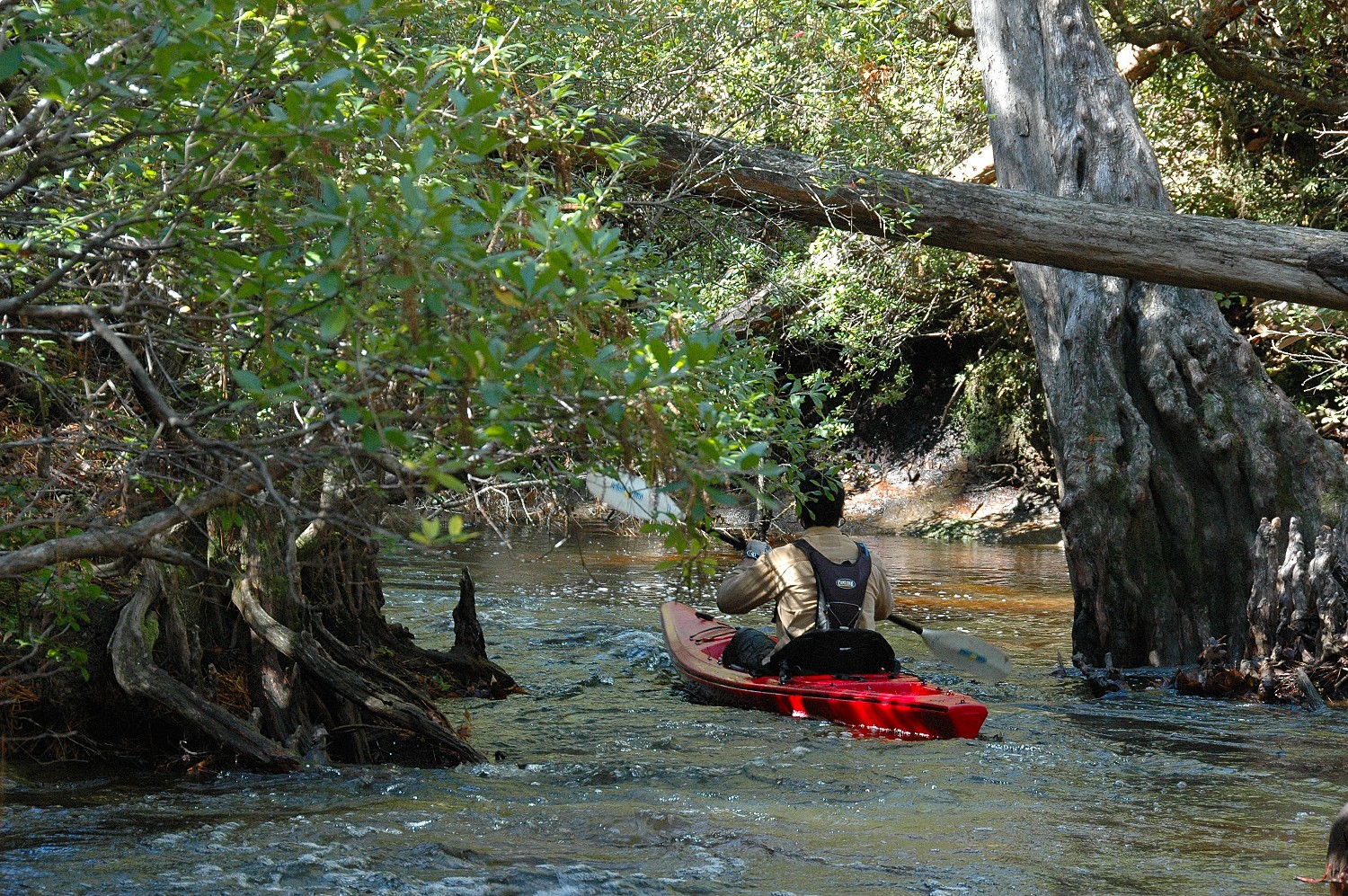
Downstream, the river is so completely undeveloped and unused by any others that the silence is nearly deafening. The most quiet river I have ever experienced. No planes. No cars. No motorboats. No lawnmowers. No chainsaws.
We speak in hushed tones as we slide along the sparkling water, not wanting to spoil the blissful experience of the sounds of silence. So quiet that one can hear a pine needle drop in the forest.
Along the way, the river is flanked by monstrous magnolia, cypress, beech and cedar trees, a scene which is particularly lovely because it is periodically splashed with red fall leaf colors in the streams of sunlight.
All in all, the Econfina is for me an unequaled experience. I have now paddled over 40 rivers and creeks in Florida. Unquestionably, the Econ is the most entertaining, gorgeously magnificent, unusual river I have ever had the pleasure of paddling.
So good that my friend and I vow to repeat the long trip (after a good rainfall) to paddle it again.
And Again.
On the day before, we drive to Pensacola. It is my first visit to the city. We have dinner at the delightful, loud, boisterous Dharma Blue restaurant. Dharma Blue is found within the Pensacola Historic District, where one finds magnificent historic homes. After dinner, I ask our waitress where we can find microbeer brewed on premises. She suggests McGuire's. A real institution. Quite a find. We enjoy a glass of fresh, yummy Irish Stout.
The first thing one notices upon entering the pub is that its walls and ceilings are COMPLETELY COVERED with dollar bills. It is as if one is looking up at the ceiling of a bat cave, which bats sardine'd together by the millions. Indeed, signs on the walls inform the newcomer that there are half a million of these donated dollars...and counting...
Another impressive display here in this happy, bustling Third Place are the many photos of illustrious people who have visited. Bob Hope. George Carlin. Tip O'Neil. Jimmy Page and Robert Plant. John McCain. Jack Kemp. Strom Thurman. Willie Mays.
While the historic district and McGuire's are both impressive, I find the city, overall, to be poisoned by an enormous number of highway overpasses, angry and multi-lane raceway roads, huge asphalt parking fields, and no "there there." Homes and offices and shops are so spread out from each other -- even in the historic area -- that travel is measured by a long car ride rather than a short walk. Driveable suburbanism rather than walkable urbanity.
"Main Street" in Pensacola shows a heroic, admirable effort to create walkability with streetscaping (on-street parking pockets, human-scaled street lighting, landscaped bulb-outs.) But it is not enough. A roaring four-lane road cannot be a walkable main street, no matter how much window-dressing is applied.
After our night in a Pensacola motel along the Rt 29 sprawlscape strip (where most of the retail dollars have apparently been sucked to), we set out for the Perdido River ("Perdido" means "lost," and probably comes from the Biblical word "perdition")
Hopefully, the name will not be our fate.
Compared to the Econ, Perdido is rather wide, despite its shallow nature. Like Econ, the current is swift, and therefore not amenable to paddling against the current.
The paddle starts off quite spectacularly, as the first bird we see gracefully flying overhead is a stupendous bald eagle.
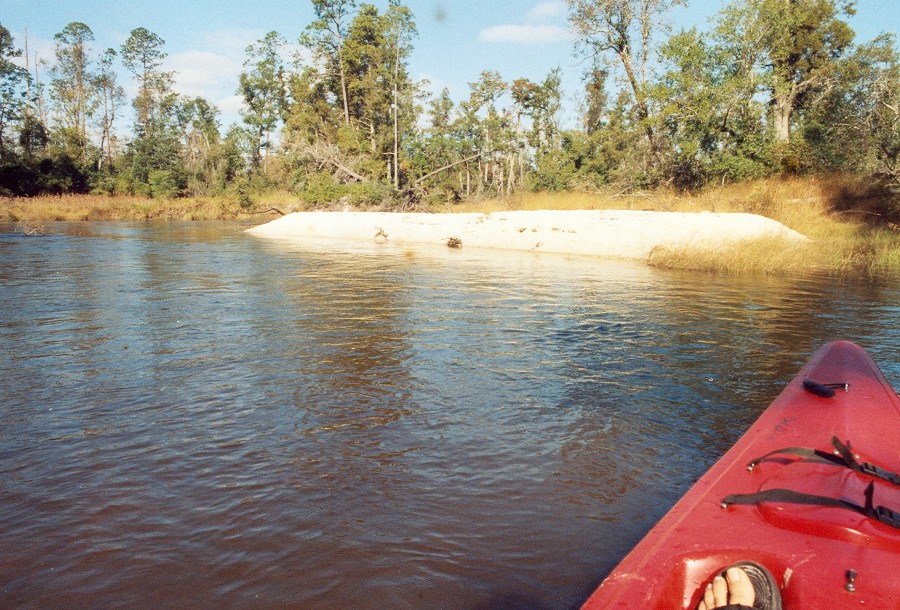
On our left along this 15-mile paddle is Florida. On our right is Alabama. The Perdido forms the boundary between the two states.
One of the most amazing aspects of the Perdido is that, like the Econ, there is absolutely no development at the water's edge. On the Alabama side, moveover, there is not even a small little dirt jeep trail within miles of the river, at least according to our Delorme's maps. The river appears to be flanked by giant expanses of undeveloped hunting grounds.
For the entire 15 miles of our Perdido trip, we see not a single person on or near the water.
Not that we were all alone, as a small herd of young deer cross the river directly in front of us. Then do so again going back to the side they came from. We enjoy watching their heads bob along as they swim across the swift current.
Perhaps the most visually impressive aspect of the beautiful Perdido are the numerous sand bars one finds along the way - many of which are perfect spots for camping. The sugar white sand bars are brilliant white in color. In the sunlight, they appear to be glowing. Almost blinding to look at due to their brilliance in the sun.
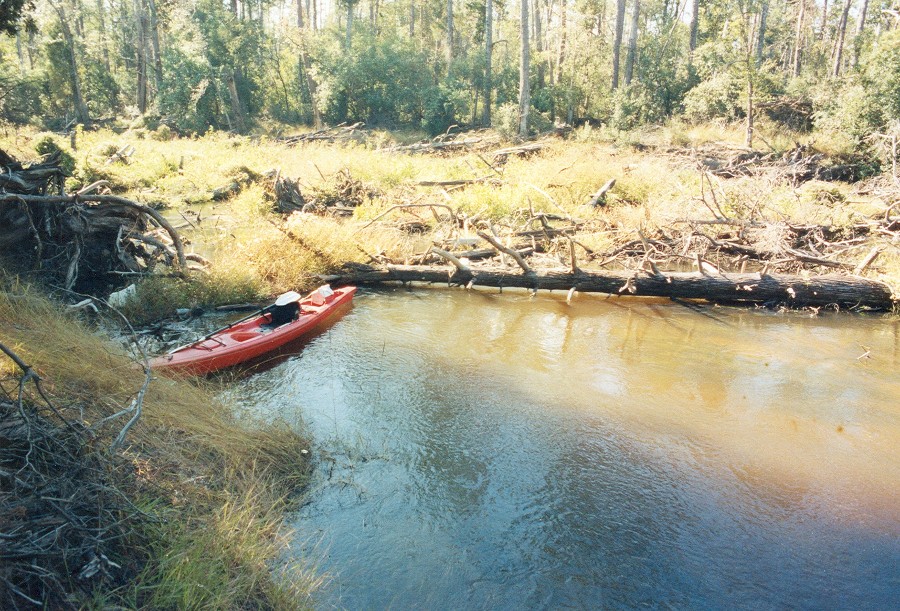
The 15-mile Perdido paddle takes us a surprisingly short period of time. Only 5.5 hours. A distance that would take at least twice as long on the flat, calm waters we are used to on the Florida peninsula.
The most important difficulty on the Perdido section we paddle is the 3 or 4 logjams we come upon. Unlike others we've experienced in the past, these jams are hundreds of feet in length, requiring a long portage through very thick, nearly impenetrable underbrush and fallen trees up on the solid ground of the flanking forest. The jams are overgrown with thick living vegetation, which suggests the jams have been in place for a great many years (see photo below).
The shallow, log-jammed Perdido (and the tree fall pull-overs on the Econ) help explain the complete lack of motorboat activity on these rivers (a delightful state of affairs for a paddler). And the absence of motorboats (and nearby development) helps explain another treat: An almost complete absence of litter and associated redneck flotsam (what my kayak companion calls "yahoo spores") along either river.
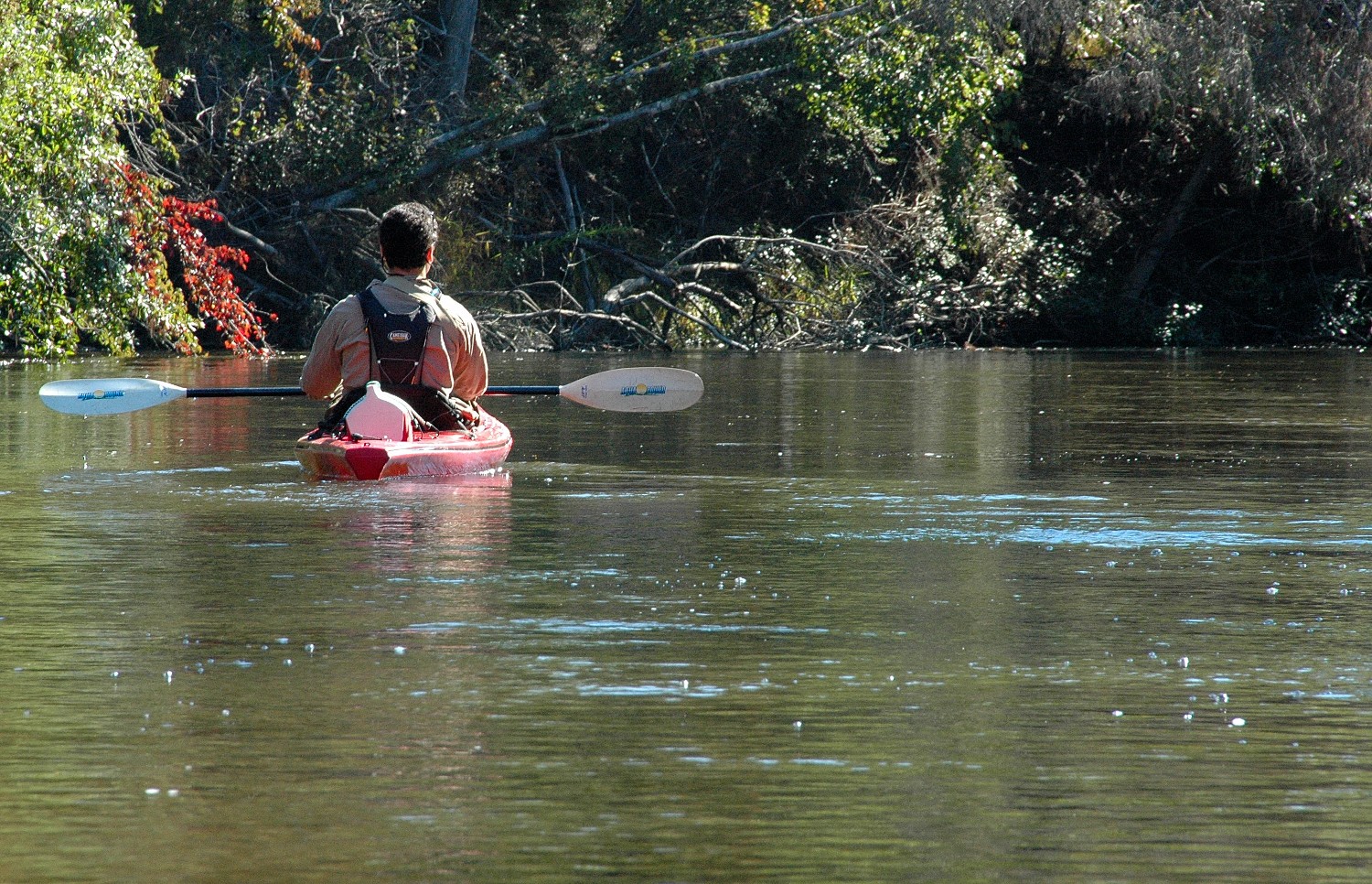
Both rivers, despite the fallen trees, are fairly well-maintained, with periodic chain-sawing activity to clear tree obstructions.
Both rivers also contain a great deal of yellow and orange gravel, a highly unusual feature for sandy Florida.
We are astounded to find that we see not a single fish or alligator (and very few birds) during our 12 hours of paddling on these two remote rivers. There surely are fish, since we regularly see Kingfisher birds skirting ahead of us on the rivers.
In sum, the Perdido River is a top-notch Florida river. I would rate it an 8 or 9 out of 10 for quality. The Econfina is clearly a 10. The most attractive, exhilarating river I've ever experienced.
I cannot wait to paddle it again.
Back to Dom's Voyages and Adventures page.